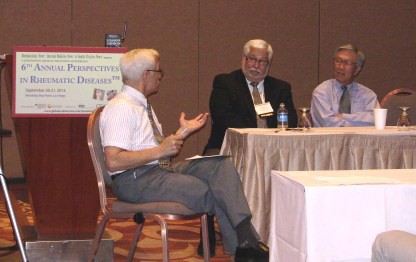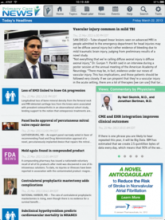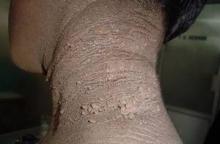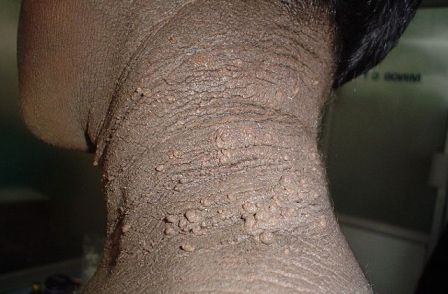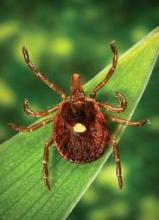User login
ACEP18: Toxicology updates & emerging trends
The dangers of synthetic drugs and heroin, and the opioid epidemic, are hitting emergency departments hard. A lack of guidelines and poor presentation to follow-up care make treatment decisions difficult. Pockets of outbreaks emerge when dangerous toxins are added to already dangerous drugs. One such regional outbreak occurred in March 2018 when synthetic cannabinoids laced with superwarfarin were led to 150 patients presenting to hospitals with severe coagulopathy in Illinois.
ACEP18 will feature a plethora of toxicology presentations and workshops, such as “Emergency Toxicology: Emerging Trends – Cases in Poisoning Management” on Tuesday, Oct. 2 at 8 am, led my Patrick M. Lank, MD, FACEP. Dr. Lark, an emergency medicine specialist in Chicago, will also be leading “Critical Update in Toxicology 2018" on Monday, Oct. 1, at 12:30 pm and “FAST FACTS: High-Yield Toxicology,” on Monday, at 4:30 pm.
The dangers of synthetic drugs and heroin, and the opioid epidemic, are hitting emergency departments hard. A lack of guidelines and poor presentation to follow-up care make treatment decisions difficult. Pockets of outbreaks emerge when dangerous toxins are added to already dangerous drugs. One such regional outbreak occurred in March 2018 when synthetic cannabinoids laced with superwarfarin were led to 150 patients presenting to hospitals with severe coagulopathy in Illinois.
ACEP18 will feature a plethora of toxicology presentations and workshops, such as “Emergency Toxicology: Emerging Trends – Cases in Poisoning Management” on Tuesday, Oct. 2 at 8 am, led my Patrick M. Lank, MD, FACEP. Dr. Lark, an emergency medicine specialist in Chicago, will also be leading “Critical Update in Toxicology 2018" on Monday, Oct. 1, at 12:30 pm and “FAST FACTS: High-Yield Toxicology,” on Monday, at 4:30 pm.
The dangers of synthetic drugs and heroin, and the opioid epidemic, are hitting emergency departments hard. A lack of guidelines and poor presentation to follow-up care make treatment decisions difficult. Pockets of outbreaks emerge when dangerous toxins are added to already dangerous drugs. One such regional outbreak occurred in March 2018 when synthetic cannabinoids laced with superwarfarin were led to 150 patients presenting to hospitals with severe coagulopathy in Illinois.
ACEP18 will feature a plethora of toxicology presentations and workshops, such as “Emergency Toxicology: Emerging Trends – Cases in Poisoning Management” on Tuesday, Oct. 2 at 8 am, led my Patrick M. Lank, MD, FACEP. Dr. Lark, an emergency medicine specialist in Chicago, will also be leading “Critical Update in Toxicology 2018" on Monday, Oct. 1, at 12:30 pm and “FAST FACTS: High-Yield Toxicology,” on Monday, at 4:30 pm.
REPORTING FROM ACEP18
Experts map out rheumatology career paths
LAS VEGAS – Three rheumatologists shared three different career routes that fellows may choose to embark on over the course of their careers.
Dr. Michael Schweitz, who has been in practice for over 30 years, presented insights into the world of private practice, as well as tips for interviewing and contract negotiation. Dr. Orrin Troum discussed taking the clinical research track, and Dr. James S. Louie explored the option of working for a pharmaceutical company. They shared their perspectives during Rheumatology Fellows Day at Perspectives in Rheumatic Diseases 2013.
PRIVATE PRACTICE
According to Dr. Schweitz, there are pros and cons of going into private practice that must be weighed. Having a private practice or being a partner in a group practice may bring more financial gain, but with that comes more responsibility, management, and liability, noted Dr. Schweitz, who has a private practice in West Palm Beach, Fla. Some physicians prefer to join a group practice as an employee.
Interviewing. When interviewing at practices, he recommended that physicians meet with all of the partners in the group to get a sense of what they are like, as well as a sense of the culture of the practice. He recommended that fellows spend a day at a practice before accepting a position, and watch how physicians interact with the staff and patients.
One of the interview tips that he offered is to make the prime focus of the interview about the practice, not about salary, vacation, or how long it takes to become partner. "Ask operational questions. Financials will work themselves out over time," he explained.
After a position has been offered, it is important to have a lawyer look at the contract. Try to find a medical business attorney, he said.
Building a practice. The best way to build a practice is by doing a good job so that patients will recommend the practice. "Your biggest source of referrals will be your patients. They will fill your schedule," he said.
When referrals come in from other physicians, call the referring physician and let him or her know that the patient was seen and what course of action was decided upon. Stress the "we," he said, so the referring physician does not feel left out of the treatment process.
Another way to build a practice is to get involved with the community. For example, give lectures at community centers, churches, and health fairs. But starting a private practice is hard, he stressed, and may not even be feasible with the current plethora of medical regulations. In an audience poll of the fellows at his lecture, no one said that they planned to start their own practice.
CLINICAL RESEARCH
Dr. Troum said that he believes that one of the most rewarding parts of doing clinical research is providing patients with medication that they would not otherwise be able to obtain. He said that it has also expanded his expertise and enriched his experience as a rheumatologist.
There are no cures for most rheumatic diseases, and some of the most common conditions among Medicare populations are arthritis (57%) and osteoporosis (16%), said Dr. Troum, clinical professor of medicine at the University of Southern California, Los Angeles. Most rheumatologists are already performing assessments required by studies every day when they are seeing patients, so participating in clinical trials should not be that difficult, he said.
However, he would never ask his patients to participate in a study that he wouldn’t participate in himself, and chooses not to participate in phase I studies, he added.
Undertaking a trial. When deciding to embark on a clinical trial, there are many regulations that need to be followed. First and foremost, patients must be advised that the drugs they are being treated with are for investigational purposes and that all requirements regarding informed consent are met, he explained. Patients must be informed of the potential dangers of the therapy, as well as the benefits. There are also reporting requirements to the sponsor (adverse events, serious adverse events, and unexpected problems).
It has to be also be ensured that all associates, colleagues, and employees assisting the study are informed and trained. Be sure to understand the investigator’s brochure and consider the risks and side effects. Good clinical practice is a requirement, and includes study design, conduct, performance monitoring, auditing, recording, analysis, and reporting to ensure a credible and accurate report.
A support staff and the proper infrastructure are key. There has to be a principal investigator, a study coordinator, and possibly a subinvestigator, a regulatory specialist, a patient recruiter, and an RN or pharmacist for studies involving intravenous drugs, Dr. Troum said.
Acquiring a study. To begin acquiring studies, new investigators can ask their medical science liaisons from pharmaceutical companies, attend industry meetings, go to seminars, ask colleagues for referrals, be introduced to company scientists, and subscribe to periodicals that publish research opportunities.
Negotiating a contract. Routinely, the sponsor of the trial will propose a lower budget than is needed to cover costs, so negotiation is important, Dr. Troum said. Never begin a study without a signed contract, he warned.
Clinical trials should be considered a separate business entity. There are overhead and costs, he said, as well as hidden costs such as purchasing dry ice and having to store documents for many years. A payment schedule should be agreed upon prior to the study. If a sponsor refuses to negotiate fair value, the study should be refused, he said.
Performing a stellar study. The best method to obtain further studies is to conduct stellar studies, Dr. Troum said. Accrue the promised number of patients, accurately and efficiently collect data, and demonstrate excellent execution of the study. All assessments and procedures should be documented.
"Successful completion of a clinical trial should be a rewarding experience for the subject and investigators," he said. Enroll patients who are willing to participate through advertising, doctor-to-doctor letters, and community outreach.
"If done properly, clinical investigation may be both intellectually and financially rewarding," he concluded.
BIOTECHNOLOGY
"Careers in biomedical industry are increasingly attractive career options," said Dr. Louie, who was the medical director for Amgen for 5 years. They are also rewarding, he said, because you have a hand in creating the most effective therapies for patients, while keeping up with the latest advances in medicine.
It is a very exciting time in rheumatology because the therapeutic landscape is changing and there are powerful new research technologies, he said. "We are progressing toward personalized medicine."
To prepare for a career in the biotechnology industry as a student or fellow, participate in the recruitment, data collection, and interpretation of clinical trials and translational research, advised Dr. Louie, professor emeritus in rheumatology at the University of California, Los Angeles. Also, investigative experience and an advanced degree should be considered (MBA, MPH, PhD).
Before accepting a position in the pharmaceutical industry, ask yourself three questions:
• How will you negotiate for your contract?
• What do you want to learn from the experience?
• What will be your exit strategy as you move to other areas of interest?
There are fundamental financial considerations in pharmaceutical/biotechnology companies, so negotiate carefully with advice from your colleagues and lawyers.
There is money in industry, so negotiate carefully, he said. And if this is the route that a fellow chooses to take, he or she should continue to attend at a teaching institute to stay current in patient treatment.
The meeting was held by Global Academy for Medical Education. GAME and this news organization are owned by Frontline Medical Communications.
LAS VEGAS – Three rheumatologists shared three different career routes that fellows may choose to embark on over the course of their careers.
Dr. Michael Schweitz, who has been in practice for over 30 years, presented insights into the world of private practice, as well as tips for interviewing and contract negotiation. Dr. Orrin Troum discussed taking the clinical research track, and Dr. James S. Louie explored the option of working for a pharmaceutical company. They shared their perspectives during Rheumatology Fellows Day at Perspectives in Rheumatic Diseases 2013.
PRIVATE PRACTICE
According to Dr. Schweitz, there are pros and cons of going into private practice that must be weighed. Having a private practice or being a partner in a group practice may bring more financial gain, but with that comes more responsibility, management, and liability, noted Dr. Schweitz, who has a private practice in West Palm Beach, Fla. Some physicians prefer to join a group practice as an employee.
Interviewing. When interviewing at practices, he recommended that physicians meet with all of the partners in the group to get a sense of what they are like, as well as a sense of the culture of the practice. He recommended that fellows spend a day at a practice before accepting a position, and watch how physicians interact with the staff and patients.
One of the interview tips that he offered is to make the prime focus of the interview about the practice, not about salary, vacation, or how long it takes to become partner. "Ask operational questions. Financials will work themselves out over time," he explained.
After a position has been offered, it is important to have a lawyer look at the contract. Try to find a medical business attorney, he said.
Building a practice. The best way to build a practice is by doing a good job so that patients will recommend the practice. "Your biggest source of referrals will be your patients. They will fill your schedule," he said.
When referrals come in from other physicians, call the referring physician and let him or her know that the patient was seen and what course of action was decided upon. Stress the "we," he said, so the referring physician does not feel left out of the treatment process.
Another way to build a practice is to get involved with the community. For example, give lectures at community centers, churches, and health fairs. But starting a private practice is hard, he stressed, and may not even be feasible with the current plethora of medical regulations. In an audience poll of the fellows at his lecture, no one said that they planned to start their own practice.
CLINICAL RESEARCH
Dr. Troum said that he believes that one of the most rewarding parts of doing clinical research is providing patients with medication that they would not otherwise be able to obtain. He said that it has also expanded his expertise and enriched his experience as a rheumatologist.
There are no cures for most rheumatic diseases, and some of the most common conditions among Medicare populations are arthritis (57%) and osteoporosis (16%), said Dr. Troum, clinical professor of medicine at the University of Southern California, Los Angeles. Most rheumatologists are already performing assessments required by studies every day when they are seeing patients, so participating in clinical trials should not be that difficult, he said.
However, he would never ask his patients to participate in a study that he wouldn’t participate in himself, and chooses not to participate in phase I studies, he added.
Undertaking a trial. When deciding to embark on a clinical trial, there are many regulations that need to be followed. First and foremost, patients must be advised that the drugs they are being treated with are for investigational purposes and that all requirements regarding informed consent are met, he explained. Patients must be informed of the potential dangers of the therapy, as well as the benefits. There are also reporting requirements to the sponsor (adverse events, serious adverse events, and unexpected problems).
It has to be also be ensured that all associates, colleagues, and employees assisting the study are informed and trained. Be sure to understand the investigator’s brochure and consider the risks and side effects. Good clinical practice is a requirement, and includes study design, conduct, performance monitoring, auditing, recording, analysis, and reporting to ensure a credible and accurate report.
A support staff and the proper infrastructure are key. There has to be a principal investigator, a study coordinator, and possibly a subinvestigator, a regulatory specialist, a patient recruiter, and an RN or pharmacist for studies involving intravenous drugs, Dr. Troum said.
Acquiring a study. To begin acquiring studies, new investigators can ask their medical science liaisons from pharmaceutical companies, attend industry meetings, go to seminars, ask colleagues for referrals, be introduced to company scientists, and subscribe to periodicals that publish research opportunities.
Negotiating a contract. Routinely, the sponsor of the trial will propose a lower budget than is needed to cover costs, so negotiation is important, Dr. Troum said. Never begin a study without a signed contract, he warned.
Clinical trials should be considered a separate business entity. There are overhead and costs, he said, as well as hidden costs such as purchasing dry ice and having to store documents for many years. A payment schedule should be agreed upon prior to the study. If a sponsor refuses to negotiate fair value, the study should be refused, he said.
Performing a stellar study. The best method to obtain further studies is to conduct stellar studies, Dr. Troum said. Accrue the promised number of patients, accurately and efficiently collect data, and demonstrate excellent execution of the study. All assessments and procedures should be documented.
"Successful completion of a clinical trial should be a rewarding experience for the subject and investigators," he said. Enroll patients who are willing to participate through advertising, doctor-to-doctor letters, and community outreach.
"If done properly, clinical investigation may be both intellectually and financially rewarding," he concluded.
BIOTECHNOLOGY
"Careers in biomedical industry are increasingly attractive career options," said Dr. Louie, who was the medical director for Amgen for 5 years. They are also rewarding, he said, because you have a hand in creating the most effective therapies for patients, while keeping up with the latest advances in medicine.
It is a very exciting time in rheumatology because the therapeutic landscape is changing and there are powerful new research technologies, he said. "We are progressing toward personalized medicine."
To prepare for a career in the biotechnology industry as a student or fellow, participate in the recruitment, data collection, and interpretation of clinical trials and translational research, advised Dr. Louie, professor emeritus in rheumatology at the University of California, Los Angeles. Also, investigative experience and an advanced degree should be considered (MBA, MPH, PhD).
Before accepting a position in the pharmaceutical industry, ask yourself three questions:
• How will you negotiate for your contract?
• What do you want to learn from the experience?
• What will be your exit strategy as you move to other areas of interest?
There are fundamental financial considerations in pharmaceutical/biotechnology companies, so negotiate carefully with advice from your colleagues and lawyers.
There is money in industry, so negotiate carefully, he said. And if this is the route that a fellow chooses to take, he or she should continue to attend at a teaching institute to stay current in patient treatment.
The meeting was held by Global Academy for Medical Education. GAME and this news organization are owned by Frontline Medical Communications.
LAS VEGAS – Three rheumatologists shared three different career routes that fellows may choose to embark on over the course of their careers.
Dr. Michael Schweitz, who has been in practice for over 30 years, presented insights into the world of private practice, as well as tips for interviewing and contract negotiation. Dr. Orrin Troum discussed taking the clinical research track, and Dr. James S. Louie explored the option of working for a pharmaceutical company. They shared their perspectives during Rheumatology Fellows Day at Perspectives in Rheumatic Diseases 2013.
PRIVATE PRACTICE
According to Dr. Schweitz, there are pros and cons of going into private practice that must be weighed. Having a private practice or being a partner in a group practice may bring more financial gain, but with that comes more responsibility, management, and liability, noted Dr. Schweitz, who has a private practice in West Palm Beach, Fla. Some physicians prefer to join a group practice as an employee.
Interviewing. When interviewing at practices, he recommended that physicians meet with all of the partners in the group to get a sense of what they are like, as well as a sense of the culture of the practice. He recommended that fellows spend a day at a practice before accepting a position, and watch how physicians interact with the staff and patients.
One of the interview tips that he offered is to make the prime focus of the interview about the practice, not about salary, vacation, or how long it takes to become partner. "Ask operational questions. Financials will work themselves out over time," he explained.
After a position has been offered, it is important to have a lawyer look at the contract. Try to find a medical business attorney, he said.
Building a practice. The best way to build a practice is by doing a good job so that patients will recommend the practice. "Your biggest source of referrals will be your patients. They will fill your schedule," he said.
When referrals come in from other physicians, call the referring physician and let him or her know that the patient was seen and what course of action was decided upon. Stress the "we," he said, so the referring physician does not feel left out of the treatment process.
Another way to build a practice is to get involved with the community. For example, give lectures at community centers, churches, and health fairs. But starting a private practice is hard, he stressed, and may not even be feasible with the current plethora of medical regulations. In an audience poll of the fellows at his lecture, no one said that they planned to start their own practice.
CLINICAL RESEARCH
Dr. Troum said that he believes that one of the most rewarding parts of doing clinical research is providing patients with medication that they would not otherwise be able to obtain. He said that it has also expanded his expertise and enriched his experience as a rheumatologist.
There are no cures for most rheumatic diseases, and some of the most common conditions among Medicare populations are arthritis (57%) and osteoporosis (16%), said Dr. Troum, clinical professor of medicine at the University of Southern California, Los Angeles. Most rheumatologists are already performing assessments required by studies every day when they are seeing patients, so participating in clinical trials should not be that difficult, he said.
However, he would never ask his patients to participate in a study that he wouldn’t participate in himself, and chooses not to participate in phase I studies, he added.
Undertaking a trial. When deciding to embark on a clinical trial, there are many regulations that need to be followed. First and foremost, patients must be advised that the drugs they are being treated with are for investigational purposes and that all requirements regarding informed consent are met, he explained. Patients must be informed of the potential dangers of the therapy, as well as the benefits. There are also reporting requirements to the sponsor (adverse events, serious adverse events, and unexpected problems).
It has to be also be ensured that all associates, colleagues, and employees assisting the study are informed and trained. Be sure to understand the investigator’s brochure and consider the risks and side effects. Good clinical practice is a requirement, and includes study design, conduct, performance monitoring, auditing, recording, analysis, and reporting to ensure a credible and accurate report.
A support staff and the proper infrastructure are key. There has to be a principal investigator, a study coordinator, and possibly a subinvestigator, a regulatory specialist, a patient recruiter, and an RN or pharmacist for studies involving intravenous drugs, Dr. Troum said.
Acquiring a study. To begin acquiring studies, new investigators can ask their medical science liaisons from pharmaceutical companies, attend industry meetings, go to seminars, ask colleagues for referrals, be introduced to company scientists, and subscribe to periodicals that publish research opportunities.
Negotiating a contract. Routinely, the sponsor of the trial will propose a lower budget than is needed to cover costs, so negotiation is important, Dr. Troum said. Never begin a study without a signed contract, he warned.
Clinical trials should be considered a separate business entity. There are overhead and costs, he said, as well as hidden costs such as purchasing dry ice and having to store documents for many years. A payment schedule should be agreed upon prior to the study. If a sponsor refuses to negotiate fair value, the study should be refused, he said.
Performing a stellar study. The best method to obtain further studies is to conduct stellar studies, Dr. Troum said. Accrue the promised number of patients, accurately and efficiently collect data, and demonstrate excellent execution of the study. All assessments and procedures should be documented.
"Successful completion of a clinical trial should be a rewarding experience for the subject and investigators," he said. Enroll patients who are willing to participate through advertising, doctor-to-doctor letters, and community outreach.
"If done properly, clinical investigation may be both intellectually and financially rewarding," he concluded.
BIOTECHNOLOGY
"Careers in biomedical industry are increasingly attractive career options," said Dr. Louie, who was the medical director for Amgen for 5 years. They are also rewarding, he said, because you have a hand in creating the most effective therapies for patients, while keeping up with the latest advances in medicine.
It is a very exciting time in rheumatology because the therapeutic landscape is changing and there are powerful new research technologies, he said. "We are progressing toward personalized medicine."
To prepare for a career in the biotechnology industry as a student or fellow, participate in the recruitment, data collection, and interpretation of clinical trials and translational research, advised Dr. Louie, professor emeritus in rheumatology at the University of California, Los Angeles. Also, investigative experience and an advanced degree should be considered (MBA, MPH, PhD).
Before accepting a position in the pharmaceutical industry, ask yourself three questions:
• How will you negotiate for your contract?
• What do you want to learn from the experience?
• What will be your exit strategy as you move to other areas of interest?
There are fundamental financial considerations in pharmaceutical/biotechnology companies, so negotiate carefully with advice from your colleagues and lawyers.
There is money in industry, so negotiate carefully, he said. And if this is the route that a fellow chooses to take, he or she should continue to attend at a teaching institute to stay current in patient treatment.
The meeting was held by Global Academy for Medical Education. GAME and this news organization are owned by Frontline Medical Communications.
EXPERT ANALYSIS FROM RHEUMATIC DISEASES 2013
Profiles in Rheumatology series receives award for publishing excellence
Rheumatology News has been presented with a 2013 APEX Award from Communications Concepts for demonstrating publishing excellence for the Profiles in Rheumatology series.
Profiles in Rheumatology, written by senior editor Sally Koch Kubetin, was a seven-part series that aimed to shine a light on rheumatologists whose teaching, mentoring, and patient care have helped pave the way for future generations of physicians in the field. Each month, an influential rheumatologist was interviewed and profiled in Rheumatology News. The three articles submitted for an APEX award were published January-March 2012.
"APEX awards are based on excellence in graphic design, editorial content, and the ability to achieve overall communications excellence," according to Communications Concepts. The annual award competition is in its 25th year.
The profiles can be viewed at the Rheumatology News website, and include "At 100, Dr. Ephraim P. Engleman Focuses on Rheumatology's Future" (August 2011, p. 66); Dr. Eric P. Gall Has Touched the Future" (September 2011, p. 56); "Dr. Roy D. Altman: The Man Behind the Hand-Painted Ties" (November 2011, p. 34); "Dr. David Wofsy: A Committed Man" (December 2011, p. 35);
"Dr. James O' Dell: A Mentor Who Matters" (January 2012, p. 31);
"Rheumatology a Deux: Dorothy Wortmann and Robert Wortmann" (February 2012, p. 32); and "Dr. Ellen Gravallese: The Face of Translational Rheumatology" (March 2012, p. 31).
Rheumatology News has been presented with a 2013 APEX Award from Communications Concepts for demonstrating publishing excellence for the Profiles in Rheumatology series.
Profiles in Rheumatology, written by senior editor Sally Koch Kubetin, was a seven-part series that aimed to shine a light on rheumatologists whose teaching, mentoring, and patient care have helped pave the way for future generations of physicians in the field. Each month, an influential rheumatologist was interviewed and profiled in Rheumatology News. The three articles submitted for an APEX award were published January-March 2012.
"APEX awards are based on excellence in graphic design, editorial content, and the ability to achieve overall communications excellence," according to Communications Concepts. The annual award competition is in its 25th year.
The profiles can be viewed at the Rheumatology News website, and include "At 100, Dr. Ephraim P. Engleman Focuses on Rheumatology's Future" (August 2011, p. 66); Dr. Eric P. Gall Has Touched the Future" (September 2011, p. 56); "Dr. Roy D. Altman: The Man Behind the Hand-Painted Ties" (November 2011, p. 34); "Dr. David Wofsy: A Committed Man" (December 2011, p. 35);
"Dr. James O' Dell: A Mentor Who Matters" (January 2012, p. 31);
"Rheumatology a Deux: Dorothy Wortmann and Robert Wortmann" (February 2012, p. 32); and "Dr. Ellen Gravallese: The Face of Translational Rheumatology" (March 2012, p. 31).
Rheumatology News has been presented with a 2013 APEX Award from Communications Concepts for demonstrating publishing excellence for the Profiles in Rheumatology series.
Profiles in Rheumatology, written by senior editor Sally Koch Kubetin, was a seven-part series that aimed to shine a light on rheumatologists whose teaching, mentoring, and patient care have helped pave the way for future generations of physicians in the field. Each month, an influential rheumatologist was interviewed and profiled in Rheumatology News. The three articles submitted for an APEX award were published January-March 2012.
"APEX awards are based on excellence in graphic design, editorial content, and the ability to achieve overall communications excellence," according to Communications Concepts. The annual award competition is in its 25th year.
The profiles can be viewed at the Rheumatology News website, and include "At 100, Dr. Ephraim P. Engleman Focuses on Rheumatology's Future" (August 2011, p. 66); Dr. Eric P. Gall Has Touched the Future" (September 2011, p. 56); "Dr. Roy D. Altman: The Man Behind the Hand-Painted Ties" (November 2011, p. 34); "Dr. David Wofsy: A Committed Man" (December 2011, p. 35);
"Dr. James O' Dell: A Mentor Who Matters" (January 2012, p. 31);
"Rheumatology a Deux: Dorothy Wortmann and Robert Wortmann" (February 2012, p. 32); and "Dr. Ellen Gravallese: The Face of Translational Rheumatology" (March 2012, p. 31).
Primary Care News app receives award for publishing excellence
IMNG Medical Media has been presented with a 2013 APEX Award from Communications Concepts for demonstrating publishing excellence in the creation of the Primary Care News iPad application.
"Apex awards are based on excellence in graphic design, editorial content, and the ability to achieve overall communications excellence," according to Communications Concepts. The annual award competition is in its 25th year.
The Primary Care News iPad app provides instant access to up-to-the-minute medical news in 31 primary care specialty areas. The free, customizable app offers global medical news and video, on-site conference coverage of hundreds of medical meetings each year, expert commentary, regulatory and legislative issues that affect medical practice, and intuitive tools for selecting the news and information most relevant to users.
The app also contains exclusive news that includes quick-read summaries, commentaries, embedded multimedia elements, and links to supporting materials and resources.
By touching on 27 categories within adult medicine, pediatric medicine, women’s health, and practice trends, app users can choose their news. Articles can be shared, saved, and commented on. At any time, users can change their personalized news feed.
Content is provided by IMNG Medical Media, the publisher of Internal Medicine News, Family Practice News, Pediatric News, and Ob.Gyn. News.
You can download the app in iTunes by searching for "Primary Care News."
IMNG Medical Media has been presented with a 2013 APEX Award from Communications Concepts for demonstrating publishing excellence in the creation of the Primary Care News iPad application.
"Apex awards are based on excellence in graphic design, editorial content, and the ability to achieve overall communications excellence," according to Communications Concepts. The annual award competition is in its 25th year.
The Primary Care News iPad app provides instant access to up-to-the-minute medical news in 31 primary care specialty areas. The free, customizable app offers global medical news and video, on-site conference coverage of hundreds of medical meetings each year, expert commentary, regulatory and legislative issues that affect medical practice, and intuitive tools for selecting the news and information most relevant to users.
The app also contains exclusive news that includes quick-read summaries, commentaries, embedded multimedia elements, and links to supporting materials and resources.
By touching on 27 categories within adult medicine, pediatric medicine, women’s health, and practice trends, app users can choose their news. Articles can be shared, saved, and commented on. At any time, users can change their personalized news feed.
Content is provided by IMNG Medical Media, the publisher of Internal Medicine News, Family Practice News, Pediatric News, and Ob.Gyn. News.
You can download the app in iTunes by searching for "Primary Care News."
IMNG Medical Media has been presented with a 2013 APEX Award from Communications Concepts for demonstrating publishing excellence in the creation of the Primary Care News iPad application.
"Apex awards are based on excellence in graphic design, editorial content, and the ability to achieve overall communications excellence," according to Communications Concepts. The annual award competition is in its 25th year.
The Primary Care News iPad app provides instant access to up-to-the-minute medical news in 31 primary care specialty areas. The free, customizable app offers global medical news and video, on-site conference coverage of hundreds of medical meetings each year, expert commentary, regulatory and legislative issues that affect medical practice, and intuitive tools for selecting the news and information most relevant to users.
The app also contains exclusive news that includes quick-read summaries, commentaries, embedded multimedia elements, and links to supporting materials and resources.
By touching on 27 categories within adult medicine, pediatric medicine, women’s health, and practice trends, app users can choose their news. Articles can be shared, saved, and commented on. At any time, users can change their personalized news feed.
Content is provided by IMNG Medical Media, the publisher of Internal Medicine News, Family Practice News, Pediatric News, and Ob.Gyn. News.
You can download the app in iTunes by searching for "Primary Care News."
PREVAIL trial results presentation pulled from ACC lineup
PREVAIL trial results were not presented during a late-breaking clinical trial session at the annual meeting of the American College of Cardiology as scheduled because of an embargo break by Boston Scientific, the device manufacturer.
According to the early released trial results, the WATCHMAN device for left atrial appendage closure met its primary safety endpoint. The risk for death, stroke, systemic embolism, and procedure or device-related complications requiring major intervention was just over 2%.
After Boston Scientific broke the embargo by releasing a press release announcing the trial results before the scheduled session at the meeting, the ACC pulled the presentation that was to be given by lead study investigator, Dr. David Holmes.
This story is developing. Check back soon for more coverage.
PREVAIL trial results were not presented during a late-breaking clinical trial session at the annual meeting of the American College of Cardiology as scheduled because of an embargo break by Boston Scientific, the device manufacturer.
According to the early released trial results, the WATCHMAN device for left atrial appendage closure met its primary safety endpoint. The risk for death, stroke, systemic embolism, and procedure or device-related complications requiring major intervention was just over 2%.
After Boston Scientific broke the embargo by releasing a press release announcing the trial results before the scheduled session at the meeting, the ACC pulled the presentation that was to be given by lead study investigator, Dr. David Holmes.
This story is developing. Check back soon for more coverage.
PREVAIL trial results were not presented during a late-breaking clinical trial session at the annual meeting of the American College of Cardiology as scheduled because of an embargo break by Boston Scientific, the device manufacturer.
According to the early released trial results, the WATCHMAN device for left atrial appendage closure met its primary safety endpoint. The risk for death, stroke, systemic embolism, and procedure or device-related complications requiring major intervention was just over 2%.
After Boston Scientific broke the embargo by releasing a press release announcing the trial results before the scheduled session at the meeting, the ACC pulled the presentation that was to be given by lead study investigator, Dr. David Holmes.
This story is developing. Check back soon for more coverage.
FROM ACC 13
Acanthosis Nigricans Severity Helps Predict Diabetes Risk
BOSTON – Patients with a high grade of acanthosis nigricans should be screened for insulin resistance, according to Dr. Sandhya Venkatswami.
His cross-sectional study found that 47 of 150 acanthosis nigricans patients (31%) were insulin resistant, with an acanthosis nigricans grade of 3 or 4 being more predictive of the condition.
"We suggest that all patients with severe AN [acanthosis nigricans] grades should be evaluated for IR [insulin resistance] and thereby prevent further complications," wrote Dr. Venkatswami, who presented his findings during a poster session at the American Academy of Dermatology’s Summer Academy Meeting.
While previous studies have found acanthosis nigricans to be a marker for prediabetes, Dr. Venkatswami’s study found that taking severity into account helps to further identify patients who may be at risk.
He and his fellow investigators enrolled 150 consecutive patients with acanthosis nigricans of the neck (25 males), aged 18-64 years. The patients were graded according to acanthosis nigricans severity on a scale of I-IV.
Grade I was defined as acanthosis nigricans that was only visible on close inspection (21 patients); grade II was defined as acanthosis nigricans confined to the base of the skull (58 patients); grade III was defined as acanthosis nigricans that extended laterally to the posterior border of the sternocleidomastoid but was not visible when the patient was facing forward (48 patients); and grade IV was defined as acanthosis nigricans that was visible when the patient was facing forward, as the acanthosis nigricans encircled the neck (23 patients), said Dr. Venkatswami of the department of dermatology, Sri Ramachandra University, Chennai, India.
One patient with grade I acanthosis nigricans was found to be insulin resistant; 10 patients with grade II acanthosis nigricans were found to be insulin resistance; 20 patients with grade III acanthosis nigricans were insulin resistant; and 16 patients with grade IV showed a resistance to insulin.
Secondary study findings showed that patients with higher grades of texture of acanthosis nigricans were also more likely to be insulin resistant. That is, those with visible and extremely coarse "hills and valleys."
"AN lesions are asymptomatic and usually ignored by the patients unless they are of cosmetic concern. However, this is of clinical importance in diagnosing prediabetes," he noted in his poster.
Further studies will look to see if behavior modifications will help lower the risk for diabetes in patients with the condition.
Dr. Venkatswami did not disclose having any conflicts of interest.
BOSTON – Patients with a high grade of acanthosis nigricans should be screened for insulin resistance, according to Dr. Sandhya Venkatswami.
His cross-sectional study found that 47 of 150 acanthosis nigricans patients (31%) were insulin resistant, with an acanthosis nigricans grade of 3 or 4 being more predictive of the condition.
"We suggest that all patients with severe AN [acanthosis nigricans] grades should be evaluated for IR [insulin resistance] and thereby prevent further complications," wrote Dr. Venkatswami, who presented his findings during a poster session at the American Academy of Dermatology’s Summer Academy Meeting.
While previous studies have found acanthosis nigricans to be a marker for prediabetes, Dr. Venkatswami’s study found that taking severity into account helps to further identify patients who may be at risk.
He and his fellow investigators enrolled 150 consecutive patients with acanthosis nigricans of the neck (25 males), aged 18-64 years. The patients were graded according to acanthosis nigricans severity on a scale of I-IV.
Grade I was defined as acanthosis nigricans that was only visible on close inspection (21 patients); grade II was defined as acanthosis nigricans confined to the base of the skull (58 patients); grade III was defined as acanthosis nigricans that extended laterally to the posterior border of the sternocleidomastoid but was not visible when the patient was facing forward (48 patients); and grade IV was defined as acanthosis nigricans that was visible when the patient was facing forward, as the acanthosis nigricans encircled the neck (23 patients), said Dr. Venkatswami of the department of dermatology, Sri Ramachandra University, Chennai, India.
One patient with grade I acanthosis nigricans was found to be insulin resistant; 10 patients with grade II acanthosis nigricans were found to be insulin resistance; 20 patients with grade III acanthosis nigricans were insulin resistant; and 16 patients with grade IV showed a resistance to insulin.
Secondary study findings showed that patients with higher grades of texture of acanthosis nigricans were also more likely to be insulin resistant. That is, those with visible and extremely coarse "hills and valleys."
"AN lesions are asymptomatic and usually ignored by the patients unless they are of cosmetic concern. However, this is of clinical importance in diagnosing prediabetes," he noted in his poster.
Further studies will look to see if behavior modifications will help lower the risk for diabetes in patients with the condition.
Dr. Venkatswami did not disclose having any conflicts of interest.
BOSTON – Patients with a high grade of acanthosis nigricans should be screened for insulin resistance, according to Dr. Sandhya Venkatswami.
His cross-sectional study found that 47 of 150 acanthosis nigricans patients (31%) were insulin resistant, with an acanthosis nigricans grade of 3 or 4 being more predictive of the condition.
"We suggest that all patients with severe AN [acanthosis nigricans] grades should be evaluated for IR [insulin resistance] and thereby prevent further complications," wrote Dr. Venkatswami, who presented his findings during a poster session at the American Academy of Dermatology’s Summer Academy Meeting.
While previous studies have found acanthosis nigricans to be a marker for prediabetes, Dr. Venkatswami’s study found that taking severity into account helps to further identify patients who may be at risk.
He and his fellow investigators enrolled 150 consecutive patients with acanthosis nigricans of the neck (25 males), aged 18-64 years. The patients were graded according to acanthosis nigricans severity on a scale of I-IV.
Grade I was defined as acanthosis nigricans that was only visible on close inspection (21 patients); grade II was defined as acanthosis nigricans confined to the base of the skull (58 patients); grade III was defined as acanthosis nigricans that extended laterally to the posterior border of the sternocleidomastoid but was not visible when the patient was facing forward (48 patients); and grade IV was defined as acanthosis nigricans that was visible when the patient was facing forward, as the acanthosis nigricans encircled the neck (23 patients), said Dr. Venkatswami of the department of dermatology, Sri Ramachandra University, Chennai, India.
One patient with grade I acanthosis nigricans was found to be insulin resistant; 10 patients with grade II acanthosis nigricans were found to be insulin resistance; 20 patients with grade III acanthosis nigricans were insulin resistant; and 16 patients with grade IV showed a resistance to insulin.
Secondary study findings showed that patients with higher grades of texture of acanthosis nigricans were also more likely to be insulin resistant. That is, those with visible and extremely coarse "hills and valleys."
"AN lesions are asymptomatic and usually ignored by the patients unless they are of cosmetic concern. However, this is of clinical importance in diagnosing prediabetes," he noted in his poster.
Further studies will look to see if behavior modifications will help lower the risk for diabetes in patients with the condition.
Dr. Venkatswami did not disclose having any conflicts of interest.
AT THE AMERICAN ACADEMY OF DERMATOLOGY'S SUMMER ACADEMY MEETING
Major Finding: Of 150 patients with acanthosis nigricans, 47 (31%) were insulin resistant.
Data Source: A cross-sectional study of 150 consecutive patients with acanthosis nigricans of the neck who presented to a dermatology practice.
Disclosures: Dr. Venkatswami did not disclose having any conflicts of interest.
Lone Star Tick Spreading Vegetarianism
Move over Lyme disease, there is a new tick borne illness in town - an allergic reaction to beef.
According to a new report from ABC News, a single bite from a lone star tick may trigger the allergy.
Researchers at the University of Virginia began to look into the ticks after the allergy began to spread along the East Coast, where lone star ticks are prevalent. The researchers noted that they have seen 400 cases of the meat allergy, mostly in Virginia, with 90% of the patients reporting a history of tick bites.
Alpha-gal antibodies, found in red meat, increase after a bite from a long star tick. Several hours after eating beef, patients with the allergy will have a reaction and develop hives, and could even go into anaphylactic shock.
The news report noted that author John Grisham, who has a plantation in Virginia, is believed to have developed the allergy.
Move over Lyme disease, there is a new tick borne illness in town - an allergic reaction to beef.
According to a new report from ABC News, a single bite from a lone star tick may trigger the allergy.
Researchers at the University of Virginia began to look into the ticks after the allergy began to spread along the East Coast, where lone star ticks are prevalent. The researchers noted that they have seen 400 cases of the meat allergy, mostly in Virginia, with 90% of the patients reporting a history of tick bites.
Alpha-gal antibodies, found in red meat, increase after a bite from a long star tick. Several hours after eating beef, patients with the allergy will have a reaction and develop hives, and could even go into anaphylactic shock.
The news report noted that author John Grisham, who has a plantation in Virginia, is believed to have developed the allergy.
Move over Lyme disease, there is a new tick borne illness in town - an allergic reaction to beef.
According to a new report from ABC News, a single bite from a lone star tick may trigger the allergy.
Researchers at the University of Virginia began to look into the ticks after the allergy began to spread along the East Coast, where lone star ticks are prevalent. The researchers noted that they have seen 400 cases of the meat allergy, mostly in Virginia, with 90% of the patients reporting a history of tick bites.
Alpha-gal antibodies, found in red meat, increase after a bite from a long star tick. Several hours after eating beef, patients with the allergy will have a reaction and develop hives, and could even go into anaphylactic shock.
The news report noted that author John Grisham, who has a plantation in Virginia, is believed to have developed the allergy.
Facial Filler Preferences Depend on Treatment Area
Dr. Joel L. Cohen shared his preferences among facial fillers for different areas of the face, and outlined his favorite techniques for achieving the best results at the SDEF Summit in Aesthetic Medicine in Dana Point, Calif.
For instance, he said that he prefers Restylane and Perlane for the periocular area below the eyes.
Dr. Cohen is in private practice in Englewood, Colo. He reported serving as a consultant or trial investigator for Allergan, Galderma, Medicis, and Merz. SDEF and this news organization are owned by Elsevier.
Dr. Joel L. Cohen shared his preferences among facial fillers for different areas of the face, and outlined his favorite techniques for achieving the best results at the SDEF Summit in Aesthetic Medicine in Dana Point, Calif.
For instance, he said that he prefers Restylane and Perlane for the periocular area below the eyes.
Dr. Cohen is in private practice in Englewood, Colo. He reported serving as a consultant or trial investigator for Allergan, Galderma, Medicis, and Merz. SDEF and this news organization are owned by Elsevier.
Dr. Joel L. Cohen shared his preferences among facial fillers for different areas of the face, and outlined his favorite techniques for achieving the best results at the SDEF Summit in Aesthetic Medicine in Dana Point, Calif.
For instance, he said that he prefers Restylane and Perlane for the periocular area below the eyes.
Dr. Cohen is in private practice in Englewood, Colo. He reported serving as a consultant or trial investigator for Allergan, Galderma, Medicis, and Merz. SDEF and this news organization are owned by Elsevier.
At-Home Hair Removal Device No Better Than Shaving
DANA POINT, CALIF. – An at-home, consumer hot-wire hair removal device worked no better than did standard shaving, according to a recent study.
"Relative to shaving, treatment with the hot-wire device did not produce statistically significant differences in the percentage change from baseline in hair count, duration of hair removal effect, or color and/or thickness of regrowing hair," Dr. Brian S. Biesman said.
There have been no controlled published studies of the no!no! hair removal device (manufactured by Radiancy) in peer-reviewed literature, which led Dr. Biesman to conduct a small study comparing the device’s efficacy with that of standard shaving.
According to information on the no!no! website, the device uses Thermicon technology "to conduct a gentle pulse of heat to the hair," which "instantly removes hair and slows the rate of hair regrowth with no pain." In Dr. Biesman’s study, however, the effectiveness of the hot-wire device, used according to the manufacturer’s recommendations (four passes per session), was found to be equivalent to standard shaving for all study end points.
For instance, active hair follicles and hair regrowth were not affected by a series of treatments with the hair removal device, compared with shaving. Also, hair thickness and color did not change after treatment with the device, Dr. Biesman reported in a poster at the Summit in Aesthetic Medicine sponsored by Skin Disease Education Foundation (SDEF).
A total of 23 patients (7 men, 16 women) aged 18-55 years completed the study; 90% of participants were white. Two sites on one leg of each patient were shaved 4 days before baseline, and then were treated every 3-4 days with the hot-wire device on one site on the leg and by shaving the other site for 8 weeks. The treatment sites were two symmetric 3 × 3 cm areas of the leg that were 3 cm apart and contained at least 15 hairs. The corners of the sites were micro-tattooed with ink, which was visible under black light.
Photographs were taken to measure hair count at baseline, weekly during treatment (before and after), at 4 days following final treatment, and at each follow-up visit (4, 8, and 12 weeks after final treatment), and "blinded visual and digital assessments were made for hair thickness and color," noted Dr. Biesman, who has a private practice in Nashville, Tenn.
The mean baseline hair count of the hot-wire and shaving sites were 86 and 79, respectively, "which remained stable during the 8-week treatment phase. No hair count reduction was seen." At post-treatment follow up, hair counts increased to 95 (treatment site) and 84 (shaving site) at 4 days, 104 and 99 at 1 month, 106 and 100 at 2 months, and 109 and 105 at 3 months. Hair regrowth was noted immediately after ceasing treatment with the hot-wire device.
The mean percent change at 4 days post treatment was 19% with the hot-wire device, compared with 14% with shaving; 41% and 41% at 1 month post treatment; 31% and 28% at 2 months post treatment; and 32% and 37% at 3 months.
A study limitation was that hair removal was evaluated only on the lower leg to sites not randomly assigned.
The study was sponsored by Tria Beauty, for which Dr. Biesman has consulted and from which he has received research support. SDEF and this news organization are owned by Elsevier.
DANA POINT, CALIF. – An at-home, consumer hot-wire hair removal device worked no better than did standard shaving, according to a recent study.
"Relative to shaving, treatment with the hot-wire device did not produce statistically significant differences in the percentage change from baseline in hair count, duration of hair removal effect, or color and/or thickness of regrowing hair," Dr. Brian S. Biesman said.
There have been no controlled published studies of the no!no! hair removal device (manufactured by Radiancy) in peer-reviewed literature, which led Dr. Biesman to conduct a small study comparing the device’s efficacy with that of standard shaving.
According to information on the no!no! website, the device uses Thermicon technology "to conduct a gentle pulse of heat to the hair," which "instantly removes hair and slows the rate of hair regrowth with no pain." In Dr. Biesman’s study, however, the effectiveness of the hot-wire device, used according to the manufacturer’s recommendations (four passes per session), was found to be equivalent to standard shaving for all study end points.
For instance, active hair follicles and hair regrowth were not affected by a series of treatments with the hair removal device, compared with shaving. Also, hair thickness and color did not change after treatment with the device, Dr. Biesman reported in a poster at the Summit in Aesthetic Medicine sponsored by Skin Disease Education Foundation (SDEF).
A total of 23 patients (7 men, 16 women) aged 18-55 years completed the study; 90% of participants were white. Two sites on one leg of each patient were shaved 4 days before baseline, and then were treated every 3-4 days with the hot-wire device on one site on the leg and by shaving the other site for 8 weeks. The treatment sites were two symmetric 3 × 3 cm areas of the leg that were 3 cm apart and contained at least 15 hairs. The corners of the sites were micro-tattooed with ink, which was visible under black light.
Photographs were taken to measure hair count at baseline, weekly during treatment (before and after), at 4 days following final treatment, and at each follow-up visit (4, 8, and 12 weeks after final treatment), and "blinded visual and digital assessments were made for hair thickness and color," noted Dr. Biesman, who has a private practice in Nashville, Tenn.
The mean baseline hair count of the hot-wire and shaving sites were 86 and 79, respectively, "which remained stable during the 8-week treatment phase. No hair count reduction was seen." At post-treatment follow up, hair counts increased to 95 (treatment site) and 84 (shaving site) at 4 days, 104 and 99 at 1 month, 106 and 100 at 2 months, and 109 and 105 at 3 months. Hair regrowth was noted immediately after ceasing treatment with the hot-wire device.
The mean percent change at 4 days post treatment was 19% with the hot-wire device, compared with 14% with shaving; 41% and 41% at 1 month post treatment; 31% and 28% at 2 months post treatment; and 32% and 37% at 3 months.
A study limitation was that hair removal was evaluated only on the lower leg to sites not randomly assigned.
The study was sponsored by Tria Beauty, for which Dr. Biesman has consulted and from which he has received research support. SDEF and this news organization are owned by Elsevier.
DANA POINT, CALIF. – An at-home, consumer hot-wire hair removal device worked no better than did standard shaving, according to a recent study.
"Relative to shaving, treatment with the hot-wire device did not produce statistically significant differences in the percentage change from baseline in hair count, duration of hair removal effect, or color and/or thickness of regrowing hair," Dr. Brian S. Biesman said.
There have been no controlled published studies of the no!no! hair removal device (manufactured by Radiancy) in peer-reviewed literature, which led Dr. Biesman to conduct a small study comparing the device’s efficacy with that of standard shaving.
According to information on the no!no! website, the device uses Thermicon technology "to conduct a gentle pulse of heat to the hair," which "instantly removes hair and slows the rate of hair regrowth with no pain." In Dr. Biesman’s study, however, the effectiveness of the hot-wire device, used according to the manufacturer’s recommendations (four passes per session), was found to be equivalent to standard shaving for all study end points.
For instance, active hair follicles and hair regrowth were not affected by a series of treatments with the hair removal device, compared with shaving. Also, hair thickness and color did not change after treatment with the device, Dr. Biesman reported in a poster at the Summit in Aesthetic Medicine sponsored by Skin Disease Education Foundation (SDEF).
A total of 23 patients (7 men, 16 women) aged 18-55 years completed the study; 90% of participants were white. Two sites on one leg of each patient were shaved 4 days before baseline, and then were treated every 3-4 days with the hot-wire device on one site on the leg and by shaving the other site for 8 weeks. The treatment sites were two symmetric 3 × 3 cm areas of the leg that were 3 cm apart and contained at least 15 hairs. The corners of the sites were micro-tattooed with ink, which was visible under black light.
Photographs were taken to measure hair count at baseline, weekly during treatment (before and after), at 4 days following final treatment, and at each follow-up visit (4, 8, and 12 weeks after final treatment), and "blinded visual and digital assessments were made for hair thickness and color," noted Dr. Biesman, who has a private practice in Nashville, Tenn.
The mean baseline hair count of the hot-wire and shaving sites were 86 and 79, respectively, "which remained stable during the 8-week treatment phase. No hair count reduction was seen." At post-treatment follow up, hair counts increased to 95 (treatment site) and 84 (shaving site) at 4 days, 104 and 99 at 1 month, 106 and 100 at 2 months, and 109 and 105 at 3 months. Hair regrowth was noted immediately after ceasing treatment with the hot-wire device.
The mean percent change at 4 days post treatment was 19% with the hot-wire device, compared with 14% with shaving; 41% and 41% at 1 month post treatment; 31% and 28% at 2 months post treatment; and 32% and 37% at 3 months.
A study limitation was that hair removal was evaluated only on the lower leg to sites not randomly assigned.
The study was sponsored by Tria Beauty, for which Dr. Biesman has consulted and from which he has received research support. SDEF and this news organization are owned by Elsevier.
FROM THE SDEF SUMMIT IN AESTHETIC MEDICINE
Major Finding: The mean percent change at 4 days post treatment was 19% with the hot-wire device, compared with 14% with shaving; 41% and 41% after 1 month; 31% and 28% after 2 months; and 32% and 37% after 3 months.
Data Source: Twenty-three patients (7 men, 16 women) aged 18-55 years completed the study; 90% of participants were white.
Disclosures: The study was sponsored by Tria Beauty, for which Dr. Biesman has consulted and from which he has received research support. SDEF and this news organization are owned by Elsevier.
Psoriasis Patients Found to Have Lower Rates of Pregnancy
WAIKOLOA, HAWAII – Multiple studies have found that psoriasis has a greater impact on women than men, and a new finding that women with psoriasis are less likely to become pregnant adds to the list of disease-related concerns.
Dr. Jennifer C. Cather and her colleagues recently completed a claims database study that found psoriasis to be significantly associated with lower rates of pregnancy and live births in women aged 35 or younger.
The Abbott-funded study matched 30,733 pairs (1:1) of women with and without psoriasis, said Dr. Cather at the annual Hawaii Dermatology Seminar, sponsored by Skin Disease Education Foundation (SDEF). Overall, women with psoriasis were found to have lower rates of pregnancy (3.1% vs. 3.6%) and live births (1.4% vs. 2.1%), compared with the women without psoriasis.
In the 7,374 matched pairs of women aged 35 or younger, the psoriasis patients had a 22% lower likelihood of pregnancy and a 39% lower likelihood of having a live birth, compared with the patients without psoriasis.
Three other recent studies on pregnancy outcomes in psoriasis offer conflicting findings; however, Dr. Cather noted that the study populations were very different for each.
The first study found that pregnant women with psoriasis are at an increased risk of having preterm delivery and low birth weight infants.
Dr. Cather reported the findings of the U.S. study of 162 pregnancies in 122 women with psoriasis, compared with 501 pregnancies in 290 women without psoriasis. The women with psoriasis were found to have a 1.89 increased risk in odds of having a poor outcome composite, compared with the patients without psoriasis (J. Invest. Dermatol. 2012;132:85-91). Psoriasis was not found to be associated with having a caesarian delivery, preeclampsia/eclampsia, or spontaneous abortion.
However, the opposite was found in a European study of 68 deliveries in 35 women with moderate-to-severe psoriasis, compared with 237 deliveries in 236 women without psoriasis. Psoriasis patients “had a higher mean of past spontaneous and induced abortions than controls,” noted Dr. Cather, who is in private practice in Dallas. The psoriasis patients also had an increased rate of pregnancy-induced hypertension, premature rupture of the membranes, large-for-gestational age babies, and macrosomia (J. Eur. Acad. Dermatol. Venereol. 2011;25:1041-7).
In the third study, 1,463 mothers with psoriasis were compared with 11,704 control patients. Pregnant Taiwanese women with psoriasis were found to have a 1.4 times increased risk of having low birth weight infants, compared with controls. Mild psoriasis did not increase the risk of low birth weight, preterm birth, small-for-gestational age infants, caesarian section, or preeclampsia/eclampsia (J. Am. Acad. Dermatol. 2011;64:71-7).
Dr. Cather noted that more studies are needed to assess the true impact of psoriasis on pregnancy.
She disclosed that she serves as a consultant to Abbott, Amgen, Centocor, and has received research grants from Amgen, Celgene, and Pfizer. SDEF and this news organization are owned by Elsevier.
WAIKOLOA, HAWAII – Multiple studies have found that psoriasis has a greater impact on women than men, and a new finding that women with psoriasis are less likely to become pregnant adds to the list of disease-related concerns.
Dr. Jennifer C. Cather and her colleagues recently completed a claims database study that found psoriasis to be significantly associated with lower rates of pregnancy and live births in women aged 35 or younger.
The Abbott-funded study matched 30,733 pairs (1:1) of women with and without psoriasis, said Dr. Cather at the annual Hawaii Dermatology Seminar, sponsored by Skin Disease Education Foundation (SDEF). Overall, women with psoriasis were found to have lower rates of pregnancy (3.1% vs. 3.6%) and live births (1.4% vs. 2.1%), compared with the women without psoriasis.
In the 7,374 matched pairs of women aged 35 or younger, the psoriasis patients had a 22% lower likelihood of pregnancy and a 39% lower likelihood of having a live birth, compared with the patients without psoriasis.
Three other recent studies on pregnancy outcomes in psoriasis offer conflicting findings; however, Dr. Cather noted that the study populations were very different for each.
The first study found that pregnant women with psoriasis are at an increased risk of having preterm delivery and low birth weight infants.
Dr. Cather reported the findings of the U.S. study of 162 pregnancies in 122 women with psoriasis, compared with 501 pregnancies in 290 women without psoriasis. The women with psoriasis were found to have a 1.89 increased risk in odds of having a poor outcome composite, compared with the patients without psoriasis (J. Invest. Dermatol. 2012;132:85-91). Psoriasis was not found to be associated with having a caesarian delivery, preeclampsia/eclampsia, or spontaneous abortion.
However, the opposite was found in a European study of 68 deliveries in 35 women with moderate-to-severe psoriasis, compared with 237 deliveries in 236 women without psoriasis. Psoriasis patients “had a higher mean of past spontaneous and induced abortions than controls,” noted Dr. Cather, who is in private practice in Dallas. The psoriasis patients also had an increased rate of pregnancy-induced hypertension, premature rupture of the membranes, large-for-gestational age babies, and macrosomia (J. Eur. Acad. Dermatol. Venereol. 2011;25:1041-7).
In the third study, 1,463 mothers with psoriasis were compared with 11,704 control patients. Pregnant Taiwanese women with psoriasis were found to have a 1.4 times increased risk of having low birth weight infants, compared with controls. Mild psoriasis did not increase the risk of low birth weight, preterm birth, small-for-gestational age infants, caesarian section, or preeclampsia/eclampsia (J. Am. Acad. Dermatol. 2011;64:71-7).
Dr. Cather noted that more studies are needed to assess the true impact of psoriasis on pregnancy.
She disclosed that she serves as a consultant to Abbott, Amgen, Centocor, and has received research grants from Amgen, Celgene, and Pfizer. SDEF and this news organization are owned by Elsevier.
WAIKOLOA, HAWAII – Multiple studies have found that psoriasis has a greater impact on women than men, and a new finding that women with psoriasis are less likely to become pregnant adds to the list of disease-related concerns.
Dr. Jennifer C. Cather and her colleagues recently completed a claims database study that found psoriasis to be significantly associated with lower rates of pregnancy and live births in women aged 35 or younger.
The Abbott-funded study matched 30,733 pairs (1:1) of women with and without psoriasis, said Dr. Cather at the annual Hawaii Dermatology Seminar, sponsored by Skin Disease Education Foundation (SDEF). Overall, women with psoriasis were found to have lower rates of pregnancy (3.1% vs. 3.6%) and live births (1.4% vs. 2.1%), compared with the women without psoriasis.
In the 7,374 matched pairs of women aged 35 or younger, the psoriasis patients had a 22% lower likelihood of pregnancy and a 39% lower likelihood of having a live birth, compared with the patients without psoriasis.
Three other recent studies on pregnancy outcomes in psoriasis offer conflicting findings; however, Dr. Cather noted that the study populations were very different for each.
The first study found that pregnant women with psoriasis are at an increased risk of having preterm delivery and low birth weight infants.
Dr. Cather reported the findings of the U.S. study of 162 pregnancies in 122 women with psoriasis, compared with 501 pregnancies in 290 women without psoriasis. The women with psoriasis were found to have a 1.89 increased risk in odds of having a poor outcome composite, compared with the patients without psoriasis (J. Invest. Dermatol. 2012;132:85-91). Psoriasis was not found to be associated with having a caesarian delivery, preeclampsia/eclampsia, or spontaneous abortion.
However, the opposite was found in a European study of 68 deliveries in 35 women with moderate-to-severe psoriasis, compared with 237 deliveries in 236 women without psoriasis. Psoriasis patients “had a higher mean of past spontaneous and induced abortions than controls,” noted Dr. Cather, who is in private practice in Dallas. The psoriasis patients also had an increased rate of pregnancy-induced hypertension, premature rupture of the membranes, large-for-gestational age babies, and macrosomia (J. Eur. Acad. Dermatol. Venereol. 2011;25:1041-7).
In the third study, 1,463 mothers with psoriasis were compared with 11,704 control patients. Pregnant Taiwanese women with psoriasis were found to have a 1.4 times increased risk of having low birth weight infants, compared with controls. Mild psoriasis did not increase the risk of low birth weight, preterm birth, small-for-gestational age infants, caesarian section, or preeclampsia/eclampsia (J. Am. Acad. Dermatol. 2011;64:71-7).
Dr. Cather noted that more studies are needed to assess the true impact of psoriasis on pregnancy.
She disclosed that she serves as a consultant to Abbott, Amgen, Centocor, and has received research grants from Amgen, Celgene, and Pfizer. SDEF and this news organization are owned by Elsevier.
FROM THE ANNUAL SDEF HAWAII DERMATOLOGY SEMINAR
Major Finding: In women aged 35 or younger, the psoriasis
patients had a 22% lower likelihood of pregnancy and a 39% lower
likelihood of having a live birth, compared with the patients without
psoriasis.
Data Source: A claims database study matched 30,733 pairs (1:1) of women with and without psoriasis, of which 7,374 matched pairs were women aged 35 or younger.
Disclosures: She disclosed that she serves as a consultant to Abbot, Amgen, Centocor,
and has received research grants from Amgen, Celgene, and Pfizer. SDEF
and this news organization are owned by Elsevier.

